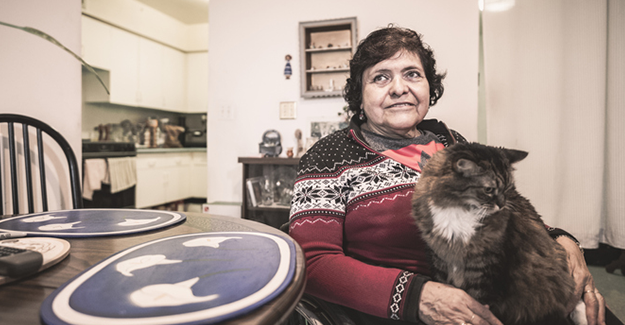Pets for Life increases access to care for underserved communities

Limited access to care affects both clients—who may feel guilt and shame that they’re unable to provide necessary treatment for their pets—and veterinary professionals, who experience distress when pet owners decline care.
And it’s not always about the money: While financial constraints can be a major barrier, cost isn’t the only factor limiting access to care in underserved communities.
Common barriers to accessing care include:
- Cost
- Language
- Cultural barriers
- Lack of trust
- Lack of transportation
- Community-specific issues
The Pets for Life (PFL) program, which is run through the Humane Society of the United States (HSUS), aims to overcome those barriers. Kevin Morris, PhD, executive director of the Institute for Human-Animal Connection at the University of Denver, has been studying PFL and its effects on both human and animal participants since 2011. He reports that in that time, PFL has provided over 1 million services to more than 250,000 households in the US and Canada.
Door-to-door outreach in veterinary medicine deserts
One of the many unique components to PFL is its door-to-door model.
Members of the PFL team assess community demographics and look for evidence of poverty, limited availability of veterinary care and pet supplies, lack of access to transportation, language barriers, and other factors that may be hindering access to veterinary care in a specific community.
When they identify a “veterinary medicine desert,” they start knocking on doors to connect with pet owners and find anyone who is eligible for the PFL program.
Community liaisons aim to form lasting relationships in these communities that help people keep their pets “for life.” This starts with establishing trust, working to overcome any language or cultural barriers, and listening to determine the specific needs of each pet owner.
PFL contracts with local veterinarians and often works out of local animal shelters. They offer free basic veterinary care and pet products, as well as providing transportation if needed, and scheduling appointments at convenient times for the community.
Studying PFL and its impacts
One of the initial studies by Morris and his team looked at the effect of race and ethnicity on the likelihood that pet owners would spay or neuter their pets when other barriers to accessing these services were removed.
They found that there was no association between race/ethnicity and likelihood to spay or neuter pet cats and dogs when community-based, culturally competent, no-cost spay/neuter services were available.
Another study looked at the effects of the PFL program on participants’ perceptions of access to both veterinary care for their pets and healthcare for themselves. This study utilized the One Health Community Assessment (OHCA), a survey that measures perceptions of access to veterinary care, human healthcare, and the environment (parks and other outdoor spaces).
Initial studies demonstrated that PFL was associated with increased perceptions of access to veterinary care. Morris reports that more recent data also shows that a perceived increased access to veterinary care also was associated with increased perception of access to human healthcare and the environment.
“Good access to veterinary care,” Morris said, “seems to improve community-wide health.”
Because of all the positive ways that the human-animal bond affects One Health, Morris believes that basic veterinary care should be accessible to all people and their pets.
“A lot of access to care is created by individual veterinarians being aware of the communities they serve” and what their needs are, Morris said. He places a strong emphasis on cultural competency, which has been associated with increased acceptance of veterinary care by pet owners.
He has noticed more veterinary schools teaching this as part of their curriculum within the last five years and calls veterinary schools “leaders in this endeavor.” The University of Denver also offers a professional certification called Animals in Human Health to enhance veterinary professionals’ skills.
Making veterinary care more accessible to everyone who needs it is an important part of One Health, and one that will benefit from continued research and innovation, he said: “We are making progress on understanding the models that work.”
Further reading
Pets for Life
https://humanepro.org/programs/pets-for-life
Race and ethnicity are not primary determinants in utilizing veterinary services in underserved communities in the United States
https://humanepro.org/sites/default/files/documents/race-and-ethnicity-are-not-primary-determinants-jaaws.pdf
Measuring Changes in Perceptions of Access to Pet Support Care in Underserved Communities
https://www.frontiersin.org/articles/10.3389/fvets.2021.745345/full#main-content
Development and initial validation of the Animal Welfare Cultural Competence Inventory (AWCCI) to assess cultural competence in animal welfare
https://www.tandfonline.com/doi/abs/10.1080/10888705.2021.2008934
University of Denver Institute for Human-Animal Interaction
https://socialwork.du.edu/humananimalconnection/about-institute-human-animal-connection
Emily Singler, VMD, writes a monthly column for NEWStat exploring One Health and the human-animal bond. She is a 2001 graduate of Penn State University and a 2005 graduate of University of Pennsylvania School of Veterinary Medicine. She has worked in shelter medicine, private practice, and as a relief veterinarian. She currently works as a veterinary writer and consultant and has her own blog, www.vetmedbaby.com.
Photo credit: © FOTOGRAFIA INC. E+ via Getty Images Plus
Disclaimer: The views expressed, and topics discussed, in any NEWStat column or article are intended to inform, educate, or entertain, and do not represent an official position by the American Animal Hospital Association (AAHA) or its Board of Directors.



